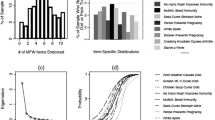Abstract
Objectives: To explore women's attitudes and practices related to douching. Methods: We conducted focus groups between July and December 1999 with 34 black and 27 white women enrolled in a managed care plan in Memphis, Tennessee. Participants were at least 18 years of age and had douched at some time in their lives. Five groups were held with black women and five with white women. Results: The focus groups identified 13 themes that fell in four broad categories: general perceptions about feminine hygiene, douching behavior, factors perpetuating douching, and health information. Each of these categories is briefly discussed with supporting evidence. Conclusions: First, women have deeply-rooted beliefs about the critical role of douching in making them feel clean. Second, douching generally starts at a young age and is reinforced by family, friends, and the media. Third, douching is a very difficult behavior to change; any efforts to influence this behavior must consider women's beliefs and the media marketing efforts that promote douching. Finally, simplistic interventions that only provide risk information about douching are not likely to result in behavior change.
Similar content being viewed by others
REFERENCES
Abma JC, Chandra A, Mosher WD, Peterson LS, Piccinino LJ. Fertility, family planning, and women's health: New data from the 1995 National Survey of Family Growth. Atlanta, GA: U.S. Department of Health and Human Services, Centers for Disease Control and Prevention, 1997.
Demographic and usage information on douching [Appendix A]. Nonprescription Drug Manufacturers Association, 1997.
Daling JR, Weiss NS, Schwartz SM, Stergachis A, Wang SP, Foy H, Chu J, McKnight B, Grayston JT. Vaginal douching and the risk of tubal pregnancy. Epidemiology 1991;2:40–8.
Chow WH, Daling JR, Weiss NS, Moore DE, Soderstrom R. Vaginal douching as a potential risk factor for tubal ectopic pregnancy. Am J Obstet Gynecol 1985;153:727–9.
Chow JM, Yonekura L, Richwald GA, Greenland S, Sweet RL, Schachter J. The association between Chlamydia trachomatis and ectopic pregnancy. JAMA 1990;263:3164–7.
Kendrick JS, Atrash HK, Strauss LT, Gargiullo PM, Ahn YW. Vaginal douching and the risk of ectopic pregnancy among black women. Am J Obstet Gynecol 1997;176:991–7.
Majeroni BA. Douching frequency [letter]. J Fam Pract 1997;45:168–9.
Merchant JS, Oh MK, Klerman LV. Douching: A problem for adolescent girls and young women. Arch Pediatr Adolesc Med 1999;153:834–7.
Zhang J, Thomas AG, Leybovich E. Vaginal douching and adverse health effects: A metaanalysis. Am J Public Health 1997;87:1207–11.
Baird DD, Weinberg CR, Voigt LF, Daling JR. Vaginal douching and reduced fertility. Am J Public Health 1996;86:844-50.
Fiscella K, Franks P, Kendrick JS, Bruce FC. The risk of low birth weight associated with vaginal douching. Obstet Gynecol 1998;92:913–7.
Aral SO, Mosher WD, Cates W. Vaginal douching among women of reproductive age in the United States: 1988. Am J Public Health 1992;82:210–4.
Stergachis A, Scholes D, Heidrich FE, Sherer DM, Holmes KK, Stamm WE. Selective screening for Chlamydia trachomatis infection in a primary care population of women. Am J Epidemiol 1993;138:143–53.
Scholes D, Stergachis A, Ichikawa LE, Heidrich FE, Holmes KK, Stamm WE. Vaginal douching as a risk factor for cervical Chlamydia trachomatis infection. Obstet Gynecol 1998;91:993–7.
Gardner JW, Schuman KL, Slattery ML, Sanborn JS, Abbott TM, Overall JC. Is vaginal douching related to cervical carcinoma? Am J Epidemiol 1991;133:368–75.
Peters RK, Thomas D, Hagan DG, Mack TM, Henderson BE. Risk factors for invasive cervical cancer among Latinas and non-Latinas in Los Angeles County. JNCI 1986;77:1063–77.
Foxman B, Aral SO, Holmes KK. Interrelationships among douching practices, risky sexual practices, and history of self-reported sexually transmitted diseases in an urban population. Sex Transm Dis 1998;25:90–9.
Forrest KA, Washington AE, Daling JR, Sweet RL. Vaginal douching as a possible risk factor for pelvic inflammatory disease. JNMA 2000;81:159–65.
Neumann HH, DeCherney A. Letter: Douching and pelvic inflammatory disease. NEJM 1976;295:789.
Scholes D, Daling JR, Stergachis A, Weiss NS, Wang SP, Grayston JT. Vaginal douching as a risk factor for acute pelvic inflammatory disease. Obstet Gynecol 1993;81:601–6.
Wolner-Hanssen P, Eschenbach DA, Paavonen J, Stevens CE, Kiviat NB, Critchlow C, DeRouen T, Koutsky L, Holmes KK. Association between vaginal douching and acute pelvic inflammatory disease. JAMA 1990;263:1936–41.
Sweet RL. Role of bacterial vaginosis in pelvic inflammatory disease. Clin Infect Dis 1995;20(Suppl 2):271–5.
Hawes SE, Hillier SL, Benedetti J, Stevens CE, Koutsky LA, Wolner-Hanssen P, Holmes KK. Hydrogen peroxideproducing Lactobacilli and acquisition of vaginal infections. J Infect Dis 1996;174:1058–63.
Sobel JD. Vaginitis. NEJM 1997;227:1896–903.
Rosenberg MJ, Phillips RS. Does douching promote ascending infection? J Reprod Med 1992;37:930–8.
Chacko MR, McGill L, Johnson TC, Smith PB, Nenney SW. Vaginal douching in teenagers attending a family planning clinic. J Adolesc Health Care 1989;10:217–9.
Snow LF. Traditional health beliefs and practices among lower class black Americans. West J Med 1983;139:820–8.
Kitzinger J. Introducing focus groups. BMJ 1995;311:299-02.
Mays N, Pope C. Rigour and qualitative research. BMJ 1995;311:109–12.
Author information
Authors and Affiliations
Corresponding author
Rights and permissions
About this article
Cite this article
Gazmararian, J.A., Bruce, F.C., Kendrick, J.S. et al. Why Do Women Douche? Results from a Qualitative Study. Matern Child Health J 5, 153–160 (2001). https://doi.org/10.1023/A:1011391700314
Issue Date:
DOI: https://doi.org/10.1023/A:1011391700314



